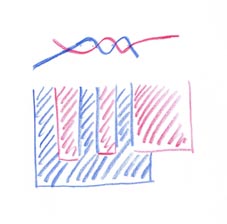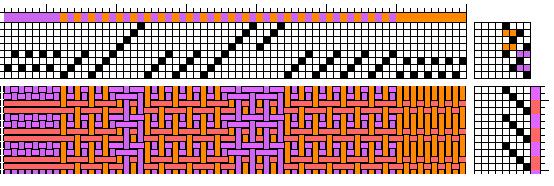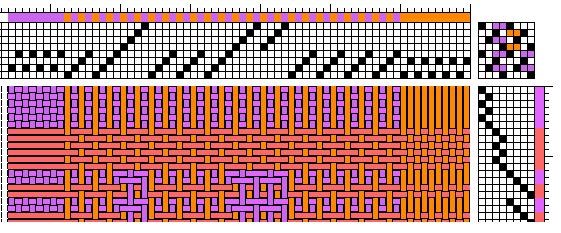How to construct a weave with double layers
Kerstin Fröberg
Meaning to make a very special shawl, I doodled:
Bergdala Spinnhus |
|
- About 4-shaft counterbalance looms (Scandinavian style) - About multi-shaft (dräll pulley) CB looms - About jämtlandsdräll - Thoughts about "overshot" - Some rag weave facts - Om vadmal - Om färgeffekt - About fabric analyis - bindningskonstruktion (opens in new window) - About construction of double layers - About weaving double width - Double width, part 2 - About profile patterns - How to expand a profile pattern - More about profile patterns - Om tagelvävning - About differential shrinkage - Solid colour? - Om datoriserad vävstol - About old wooden reeds - About reading old literature - About Hulda Peters vävbok - threading notations, part 1 - threading notations, part 2 - About horsehair - Tageltyg från Småland - ideas about displaying - "Original", kopia eller plagiat? - A survey of Swedish weaving books - Om tyst kunskap - Nog nu! in English: - Serial weaving - "TWILL" - Block substitution - Vadmal |
|
How to construct a weave with double layersKerstin Fröberg Meaning to make a very special shawl, I doodled: |
|

|
The cross section is seen at the top: both layers have their own selvedges. From left to right we have two layers that
interchange three times. Both warps are the same width, but the red one is shifted to the right.
|
||
|
To make the construction, I used a weaving software (Fiberworks PCW). I used the software almost as if it were graph paper,
for a couple of reasons: it is important to understand both the weave structure and the software. Fiberworks does not
handle double layers the way I wanted this particular weave to function, therefore I found it easiest to do the whole
construction manually.
This is how I did it: Both layers were to be plain weave. To weave two layers of plain weave we need four shafts. As the shawl has two blocks we need a total of eight shafts. I choose to thread the orange ends on odd shafts (1 and 3 for one block, 5 and 7 for the other). The purple ends get threaded on the even-numbered shafts. Where both warps/layers coincide I place the colours one-by-one. Like this: 
To make weaving easier I want to make two picks in each layer. I decide that the orange layer is to come first, and that it is to be on top where the free selvedges are. (Note: the following is made for a sinking-shed loom. The reasoning works for any kind of loom, but the resulting tie-up for a rising-shed loom will be the opposite of my result.) Mark the plain weave in the orange layer. (This can be done either in the drawdown area or in the tie-up area - the result is the same) 
The orange layer shall be on top in the block threaded on shafts 1-4. Therefore the purple layer must be tied to sink. Like this: 
We go on to the purple layer. The plain weave is marked: 
We can see that we have to do something to block # 2, where the purple layer is meant to be on top. We need to tie the orange layer to sink. Like this: 
If we want to be able to weave both layers separately (like I did on the shawl - se pictures below), we need another four treadles - two per layer. To start with the orange layer: it shall be on top, therefore all shafts with purple ends need to be tied to sink: 
The purple layer shall stay at the bottom: 
The finished shawl: |
|||

|
The shawl on the loom, almost ready: woven in cotton 16/2 and 20/2, three nuances of purple and five of orange. It had 10 ends and 9 picks per centimeter. After wet finishing it had shrunk almost exactly 10% in both length and width. A word of warning: do not make too long warps! The fact that the web has single layers at the sides, but double in the middle, will disturb the warp tension. I had problems already after about 150 cm woven - the sides got slacker than the middle. |
||

Detail of both ends, with "free" layers in different lengths.
|

Finished!
|
||
© Kerstin Fröberg 2005